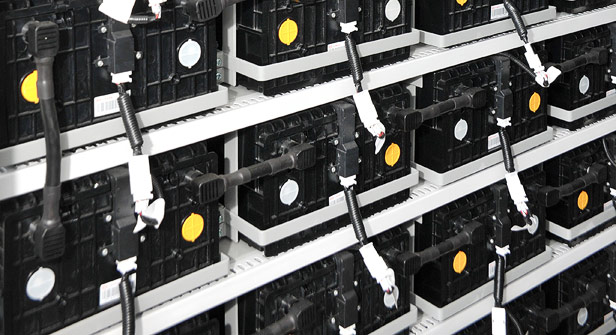Microgrid Keeps the Power Local, Cheap, and Reliable

A recently completed distributed energy project at the large, 4,000-inmate Santa Rita Jail in Alameda County, California, ties together power from fuel cells, solar panels, wind turbines, and diesel generators—all located at the jail—to form a microgrid that can operate independently of large, centralized power plants. The system keeps the power on when storms take down the grid, which is essential for safety at the maximum security facility, and it’s saving the jail about $100,000 a year.
The jail microgrid is one of the largest and most advanced in the United States. It’s the latest example of an emerging smart-grid technology that’s providing a cleaner, more reliable, and, in some parts of the country, significantly cheaper alternative to the conventional grid. “In many cases, it has a very nice payback, with or without subsidies,” says Michael Clark, president of Fort Collins, Colorado-based Encorp, which recently installed the software and equipment needed to manage the jail’s microgrid. Microgrids also provide new ways to use solar and wind power. Ordinarily, the intermittent nature of such power sources makes them a challenge for utilities. By integrating them with batteries and other sources of power, they can provide a reliable boost to conventional power supplies to help utilities meet peaks in demand.
Microgrids are a step beyond either emergency backup systems or stand-alone solar-panel arrays. They use special software and power electronics to integrate multiple sources of power and energy storage to provide electricity around the clock, even when the sun isn’t shining or regulations limit the use of diesel generators. In the case of the system at the jail, Encorp has installed networked controllers—the size of large computers—at each source of electricity, including a large array of thousands of batteries, as well as at the point where the jail connects to the grid. Coordinating power from diesel generators, solar panels, and other sources of power also requires equipment that can adjust the frequency and voltage of the power they produce.
Clark says Encorp has developed algorithms to help the system get the most out of each power source. At the jail, where the system is connected to the grid, this includes responding to the needs of a utility. If the utility experiences a large spike in demand, the microgrid can respond by selling excess power to the utility.
At certain times, it makes sense to use the system’s ability to temporarily decrease power consumption at the jail for things like the air-conditioning or lighting to create more excess power to sell to the grid.
The first customers for microgrids are businesses and organizations that can’t afford even short power outages—such as jails, hospitals, data centers, and military bases—or remote areas that don’t have access to the grid. They make economic sense in places such as California, where electricity costs are high and regulations on backup generators are strict. But they could soon make sense in more places as the cost of renewable energy and large-scale batteries decreases, and as advanced controls and power electronics make them more efficient. (See “New Solar Panel Designs Make Installation Cheaper,” “GE’s Novel Battery to Bolster the Grid,” and “Battery to Take on Diesel and Natural Gas.”)
Keep Reading
Most Popular
Large language models can do jaw-dropping things. But nobody knows exactly why.
And that's a problem. Figuring it out is one of the biggest scientific puzzles of our time and a crucial step towards controlling more powerful future models.
The problem with plug-in hybrids? Their drivers.
Plug-in hybrids are often sold as a transition to EVs, but new data from Europe shows we’re still underestimating the emissions they produce.
Google DeepMind’s new generative model makes Super Mario–like games from scratch
Genie learns how to control games by watching hours and hours of video. It could help train next-gen robots too.
How scientists traced a mysterious covid case back to six toilets
When wastewater surveillance turns into a hunt for a single infected individual, the ethics get tricky.
Stay connected
Get the latest updates from
MIT Technology Review
Discover special offers, top stories, upcoming events, and more.